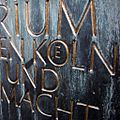Ö facts for kids
The letter Ö (uppercase) or ö (lowercase) is a special letter you won't find in the English alphabet. It's used in many other languages around the world. Some of these include German, Finnish, Estonian, Hungarian, Turkish, and Swedish. This letter often makes a sound similar to the "ur" in "fur" or the "i" in "bird" in English, but it can vary between languages.
Contents
The Letter Ö in German
The letter Ö is an important part of the German alphabet. It is one of four special letters, called "umlauts," that are different from the basic English letters. The other umlauts are Ä, Ü, and ß.
How Ö is Used in Germany and Austria
In Germany and Austria, the letter Ö is used in many words. For example, the German word for "oil" is Öl, and the word for "East" is Osten, but the word for "Easter" is Ostern.
Sometimes, if you can't type Ö, you can replace it with "Oe" (or "oe" for lowercase). For example, the city of Cologne, which is Köln in German, might sometimes be written as Koeln. This replacement is especially common for internet addresses because most web systems only understand the basic English alphabet. So, a website name that should have an Ö will use "oe" instead.
It's important to know that simply writing "O" instead of "Ö" is not correct in German. It changes the word's meaning or makes it hard to understand.
The Ö in Swiss German
German is one of the official languages spoken in Switzerland. The German spoken there has its own unique style, called Swiss-German or Schweizerdeutsch. Just like in Germany and Austria, the letter Ö (and other umlauts) is also used in the Swiss-German dialect. This shows how important the letter Ö is across different German-speaking regions.
Images for kids
-
An unusual way of writing the Œ or Ö ligature, with a small E inside the O. This comes from an inscription in the crypt of Cologne (Köln) Cathedral.
See also
 In Spanish: Ö para niños
In Spanish: Ö para niños



